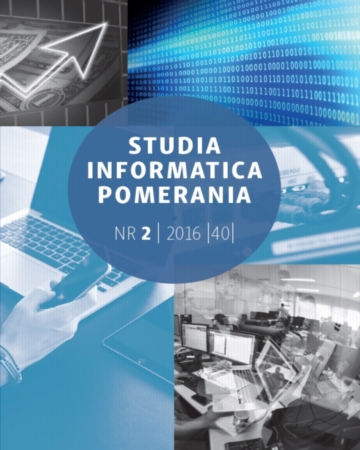
ISSN: 2451-0424
eISSN: 2300-410X
OAI
DOI: 10.18276/si.2017.45-04


Lista wydań /
nr 45
Doskonalenie procesów ponadorganizacyjnych w e-biznesie
| Autorzy: |
Jerzy
Marcinkiewicz
Uniwersytet Szczeciński, Wydział Nauk Ekonomicznych i Zarządzania |
| Słowa kluczowe: | procesy ponadorganizacyjne proces biznesowy Reengineering X-engineering model procesu e-Sourcing modernizacja procesu biznesowego |
| Data publikacji całości: | 2017-12-06 |
| Liczba stron: | 14 (39-52) |
Abstrakt
Artykuł porusza zagadnienie modernizacji biznesowych procesów ponadorganizacyjnych, realizowanych pomiędzy organizacjami. Punktem wyjścia do analizy problemu jest technika X-engineeringu zaproponowana dla potrzeb modernizacji tej kategorii procesów. Doskonalenie procesów ponadorganizacyjnych wymaga optymalnego zastosowania technologii teleinformatycznych. Artykuł prezentuje podstawowe modele informatyzacji procesu, jak również wzorce wykorzystywane przy definiowaniu rozwiązania zapewniającego uwzględnienie wymagań i interesów wszystkich użytkowników procesu. Zarysowano również metodologię postępowania w trakcie modernizacji procesów ponadorganizacyjnych.
Pobierz plik
Plik artykułu
Bibliografia
| 1. | Bitkowska, A. (2009). Zarządzanie procesami biznesowymi w przedsiębiorstwie. Warszawa: VIZJA PRESS & IT. |
| 2. | Champy, J. (2003). X-engineering przedsiębiorstwa. Warszawa: Wydawnictwo PLACET. |
| 3. | Hammer, M., Champy J. (1999). Reengineering w przedsiębiorstwie. Warszawa: Neumann Management Institut. |
| 4. | Hartmann, P., Studt, R., Wewers, T. (2001). A Framework for Classifying Interorganizational Workflow-Controlled Business Processes Focusing on Quality Management. Published in System Sciences. Proceedings of the 34th Hawaii International Conference on. Washington. |
| 5. | Martinez-Araisa, U., Lopez-Mellado, E. (2016). CTL Model Repair for Inter-organizational Business Processes Model¬led as o WFN. IFAC-Papers OnLine , 49 (2), 6–11 . |
| 6. | Norta, A., Grefen, P., Narendra, N. ( 2014). A reference architecture for managing dynamic inter-organizational busi¬ness processes. Data & Knowledge Engineering, 91, 52–89. |
| 7. | Norta, A., Eshuis, R. (2010). Specification and verification of harmonized business-process collaborations. Information Systems Frontiers, 12, 457–479. |
| 8. | Oracle Sourcing. (2016). Oracle Data Sheets. |
| 9. | Rittgen, P. (2009). Self-organization of interorganizational process design. Electron Markets, 19, 189–199. |
| 10. | Venkatesh, V., Bala, H. (2012). Adoption and Impacts of Interorganizational Business Process Standards: Role of Part¬nering Synergy. Information Systems Research, 4 (23), 1131–1157. |
| 11. | Yongchareon S., Chengfei l., Jian Y., Zhao X. (2015). A view framework for modeling and change validation of artifact¬-centric inter-organizational business processes. Information Systems 47, 51–81. |
| 12. | Zapletal, M., Schuster, R. i in. ( 2010). Modeling Interorganizational Business Processes. W: J. vom Brocke, M. Rose¬mann (red.), Handbook on Business Process Management 1. Berlin– Heidelberg: Springer-Verlag. |
| 13. | OfficeObjects®WorkFlow. Pobrane z: http://www.rodan.pl/web/guest/oferta/platforma_officeobjects/officeobjects -workflow. |
| 14. | SAP® Ariba®. Pobrane z: www.ariba.com. |
| 15. | SharePoint: Empowering Teamwork (2016). Pobrane z: http://www.lmja.com/blog/sharepoint-empowering-teamwork/. |
| 16. | Secrets to x-engineering the corporation (2003). Pobrane z: http://searchcio.techtarget.com/news/914542/Secrets- -to-x-engineering-the-corporation. |
| 17. | Strategic Sourcing Solutions. Pobrane z: http://www.ariba.com/solutions/buy/strategic-sourcing-solutions.\ |